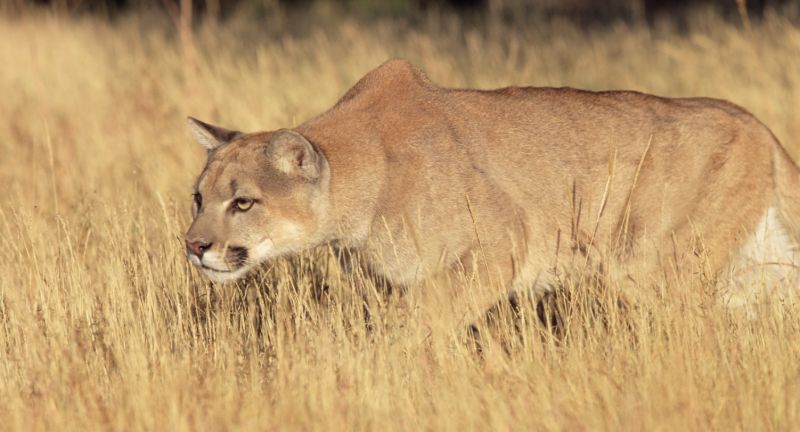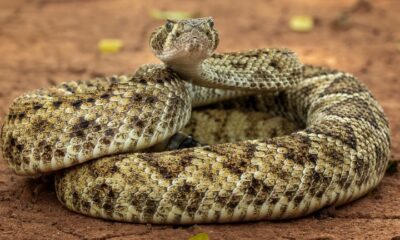NEWS
19 Astonishing Facts About Mountain Lions Most Didn’t Know
Published
4 months agoon

Shutterstock
Silent and elusive, mountain lions are some of the most intriguing predators in the animal kingdom. These powerful big cats can leap up to 40 feet in a single bound and thrive in a variety of habitats, from snowy mountain ranges to arid deserts. Despite their solitary nature, they play a critical role in maintaining ecological balance, controlling prey populations and influencing entire ecosystems.
Yet, many myths and misunderstandings surround these mysterious creatures, sparking both fear and fascination. Dive into the world of the mountain lion to uncover surprising truths about their behaviors, habitats, and the vital role they play in the wild.
Wide Range of Names

Shutterstock
Mountain lions go by many names, including cougar, puma, panther, and catamount, making them the animal with the most names in the world. This is a reflection of their vast geographic range and cultural significance. In the scientific community, they are called Puma concolor, meaning “cat of one color.” Each name represents a unique connection to the regions and peoples that encounter this extraordinary feline.
Largest Range of Any Mammal in the Americas

Shutterstock
Mountain lions have the largest geographic range of any terrestrial mammal in the Western Hemisphere. They are found from Canada’s Yukon to the southern Andes in South America. Their adaptability to different climates and terrains has allowed them to thrive in environments ranging from snow-covered mountains to tropical forests. This wide range highlights their extraordinary resilience as a species.
Incredible Jumping Ability

Shutterstock
Mountain lions are incredible athletes, capable of leaping up to 40 feet horizontally and 15 feet vertically. This makes them one of the best jumpers in the animal kingdom. Their powerful hind legs are designed for springing great distances, helping them catch prey or evade threats. Watching a mountain lion in motion is a testament to the strength and precision of nature’s design.
Silent Hunters

Shutterstock
Known as “ghosts of the wilderness,” mountain lions are stealthy and elusive hunters. They can stalk prey for hours, remaining virtually undetected until the perfect moment to strike. This incredible ability to move silently has earned them their reputation as one of nature’s most efficient predators. Their skill in remaining unseen is a key to their survival in the wild.
Solitary Lifestyle

Shutterstock
Mountain lions are solitary creatures, rarely seen in groups. Apart from mothers with cubs, these cats prefer to roam and hunt alone. Their territories can span hundreds of square miles, with individuals fiercely defending their range from intruders. This solitary nature ensures less competition for food and mates in their vast home ranges.
Versatile Diet

iStock
Mountain lions are carnivorous, but they aren’t picky eaters. While they primarily prey on deer, they can also hunt smaller animals like rabbits, raccoons, and even insects if necessary. Their ability to adapt their diet to available resources helps them survive in various environments. This flexibility has made them apex predators in many ecosystems.
Superb Camouflage

Shutterstock
Their tawny coats provide excellent camouflage, blending seamlessly into their surroundings. Whether stalking through dense forests or lying low in desert scrub, their coloration allows them to approach prey undetected. This natural camouflage also helps them avoid detection by humans and other potential threats. Their stealthy coloration is a vital part of their predatory arsenal.
Amazing Speed

Shutterstock
Mountain lions can sprint up to 50 miles per hour, though they prefer short bursts of speed during hunts. While they lack the endurance of cheetahs, their acceleration is perfect for ambushing prey. This speed, combined with their agility, makes them deadly predators. Despite their quickness, they rely more on strategy and stealth than on pure speed.
Excellent Climbers

Shutterstock
Mountain lions are expert climbers and often use trees to escape danger or gain an advantageous position. Their retractable claws and muscular build allow them to scale vertical surfaces with ease. Cubs often practice climbing skills at a young age, perfecting the techniques needed to survive in the wild. Climbing also provides a safe retreat from larger predators like bears.
Night Hunters

Shutterstock
Mountain lions are crepuscular, meaning they are most active during dawn and dusk, but they also hunt at night. Their excellent night vision, six times better than humans, helps them navigate and locate prey in low-light conditions. Their nocturnal tendencies help them avoid human interaction and other potential dangers. The cover of darkness enhances their already formidable hunting skills.
Long Lifespan

iStock
In the wild, mountain lions can live up to 12 years, and in captivity, they may reach 20 years. Their longevity depends on factors like food availability, habitat quality, and threats from humans or other predators. They face numerous challenges in the wild, including competition and habitat encroachment. Despite these challenges, their adaptability contributes to their survival.
Vocal But Not Roaring

Shutterstock
Unlike lions, mountain lions cannot roar due to differences in their vocal cords. However, they are capable of producing a wide range of sounds, including growls, purrs, hisses, and even high-pitched screams that resemble a woman’s cry. These eerie vocalizations are often heard during mating season or as territorial warnings. Their distinctive calls have contributed to myths and folklore.
Mothers Are Dedicated

Shutterstock
Female mountain lions are devoted mothers, raising their cubs alone. A typical litter consists of two to four cubs, which stay with their mother for up to two years. During this time, the mother teaches them critical survival skills like hunting and territory navigation. Their maternal care ensures the continuation of the species in challenging environments.
Keen Senses

Shutterstock
Mountain lions possess acute senses of sight, hearing, and smell, making them highly effective predators. Their sharp vision allows them to detect motion from great distances, even at night. Their keen hearing can pick up faint sounds of prey moving through the brush. These heightened senses make them perfectly suited for their stealthy, predatory lifestyle.
Habitat Flexibility

Shutterstock
Mountain lions are found in diverse habitats, from arid deserts to dense forests and high mountains. Their ability to adapt to various climates and environments has allowed them to thrive across two continents. This flexibility also means they can coexist with humans in some areas, though such encounters are rare. Their habitat adaptability is a hallmark of their resilience.
Territorial Beasts

Shutterstock
Mountain lions are highly territorial and use scent markings to communicate their presence. They scrape the ground, urinate, or leave claw marks on trees to warn other cougars to stay away. These territorial behaviors reduce conflicts and ensure sufficient resources within their range. Each territory is fiercely defended, especially by males.
Important Ecological Role

Shutterstock
As apex predators, mountain lions play a critical role in maintaining ecosystem balance. They help regulate prey populations, which in turn influences vegetation and other wildlife. By controlling herbivore numbers, they prevent overgrazing and promote biodiversity. Their presence is a sign of a healthy, functioning ecosystem.
Threatened by Habitat Loss

Shutterstock
While mountain lions are not currently endangered, habitat loss and fragmentation pose significant threats to their survival. Urbanization and infrastructure development often encroach on their natural ranges, leading to increased human-wildlife conflicts. Conservation efforts aim to create wildlife corridors to connect fragmented habitats. Protecting their habitats ensures the survival of these majestic predators.
They Rarely Attack Humans

Shutterstock
Despite their fearsome reputation, mountain lion attacks on humans are exceedingly rare. Most mountain lions are shy and avoid human contact whenever possible. When attacks do occur, they are usually due to territorial disputes or starvation driving the animal to desperation. Awareness and education about coexistence are key to preventing conflicts with these elusive cats.
Conclusion

Shutterstock
Mountain lions are more than just symbols of wilderness; they are essential keystones in the ecosystems they inhabit. Understanding and respecting these magnificent creatures helps dispel myths and fosters coexistence between humans and wildlife. By protecting their habitats and learning to live alongside them, we contribute to a healthier, more balanced environment for all species. Embracing the wonder of mountain lions reminds us of nature’s incredible power and interconnectedness.
More Amazing Animals+
-


Goats Ushered Across a Road to Aid in California Fire…
-


20 Most Expensive Cat Breeds Around The World
-


More – Orphaned bear cubs playing in tree and post-rescue…
-


24 of the Most Dangerous Animals Roaming Texas
-


25 Reasons Why Pekingese Are the Most Regal Lap Dogs
-


30 Reasons Miniature Schnauzers Are a Top Choice for Dog…
-


25 Reasons Why Chihuahuas Are Big Dogs in Small Packages
-


Alligator strolls with police escort prior to being picked up…
-


17 Easy Ways to Sharpen Your Dog’s Mind
-


Aerial footage of shark-infested waters in Pasco County, FL
-


25 Hilarious Habits of Pugs That Dog Owners Adore
-


25 Outstanding Qualities of the Golden Retriever
